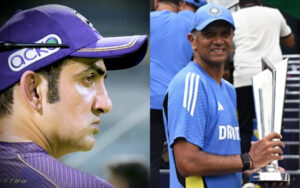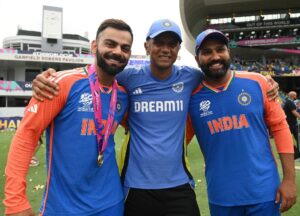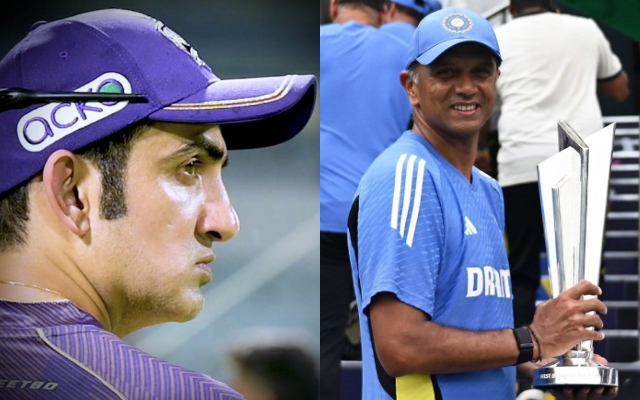
It was the time for emotional outpouring. India won another T20 World Cup after a gap of 17 years and as the players and coaching staff were celebrating at Kensington Oval, Virat Kohli went into Rahul Dravid’s embrace and shed a tear.
Not far from them, Hardik Pandya was talking to the host broadcaster and eulogising the head coach. The entire team then decided to toss Dravid in the air. Kohli and Rohit Sharma led the way. The great man was bidding farewell to the Indian cricket team with a world champion’s medal around his neck. His players wanted to make the occasion memorable. Dravid will be missed in that dressing room. He coached the team, mentored the boys but above all, he was a friend, despite the age difference.
As Dravid said tongue in cheek, from next week he would be “unemployed”. Unless there’s a last-minute change, Gautam Gambhir will take charge this month and it will not be easy for him to step into his predecessor’s shoes. To start with, he will have to build a new team in the shortest format, with the seniors exiting the stage en masse – Rohit, Kohli and Ravindra Jadeja. But Indian cricket’s talent pool should make the transition smooth, at least in white-ball cricket.
The challenge for any coach at this level is to gel with the side. Given Gambhir’s dislike for Indian cricket’s star culture, he might be happy to deal with a younger bunch of players. One of the conditions he reportedly set out, as the BCCI approached him to become Dravid’s successor, is to have separate teams for red-ball and white-ball formats.
For the Latest Sports News: Click Here

Maybe, Rohit and Kohli read the writing on the wall and decided to leave on their own terms. After the final on Saturday, Rohit was asked about his decision to retire from T20Is. “I didn’t think I would retire from T20Is, but situation aysa aageya hai (the situation is such), I thought it was the perfect situation for me,” the India captain told reporters. “Nothing better than winning the Cup and saying goodbye.”
Between the lines, Rohit’s comment leaves enough scope for interpretation, and as he and Kohli would continue to play Tests and ODIs, it would be interesting to see how they work with the new coach.
When a popular coach leaves, his successor usually finds it difficult to win over the players. Greg Chappell faced the problem big-time, after taking over from John Wright. Duncan Fletcher didn’t find it easy after he replaced Gary Kirsten, although unlike Chappell, Fletcher never tried to rock the boat. The failure to handle transition properly became his bugbear. The Indian team (read, Kohli) found Anil Kumble too imposing and it ended up in the latter’s acrimonious exit. The transition from Ravi Shastri to Dravid, however, was almost seamless, as both showed excellent man-management skills.
As the Kolkata Knight Riders mentor, Gambhir treated the stars as commoners. He gave the junior cricketers the required space to perform without fear, while senior pros were in sync with his methods. The Indian team, though, is a different kettle of fish, full of superstars and strong egos. And for the time being, there will be a carry-over effect of Dravid’s stint.
The important thing for Gambhir would be to make his mark without ruffling many feathers. He will have to earn the players’ trust before making everyone sing from the same hymn sheet. The process should be gradual.
Also Read: The return of Hardik Pandya




